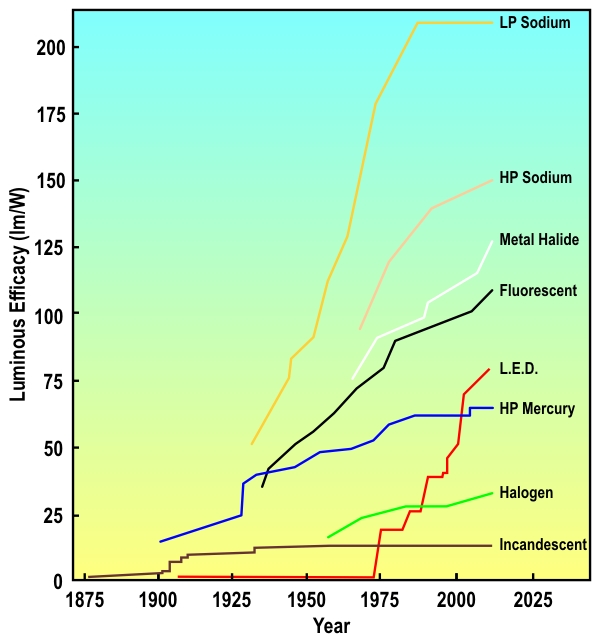|
|
|
|
|
Introduction
The incandescent lamp is the oldest type of electric lamp still in general use. Its practical form was invented simultaneously in 1879 by Sir Joseph Swan in England, and by Thomas Edison in America. Over the past 130 years it has undergone numerous changes in materials and manufacture to bring it to its present performance and convenience as a light source. Fig. I1 illustrates the construction of a typical modern incandescent lamp.
|
 Figure I1 - A Typical Incandescent Lamp
Figure I1 - A Typical Incandescent Lamp
|
Until recently the incandescent lamp was found in almost every application, and despite the fact that it is the least efficient technology for the conversion of electrical energy into visible light, and the fact that several considerably more efficient retrofit lamp types have been developed, until 2010 the incandescent lamp still accounted for a greater quantity made annually than any other lamp type. Perhaps a testament to the effectiveness, popularity and simplicity of its design in the eyes of the consumer is that no other light source has shown sufficiently strong technical features to be able to truly displace incandescent lighting. For decades the ordinary man has been wlling to pay the price of its low efficacy in order to enjoy its other benefits. In the end it was only by poltical intervetion, by way of the banning of incandescent lamps so as to reduce global energy consumption, that it has been possible to enforce a transition to more energy-efficient light sources. However incandescent technology continues to survive in the form of its slightly more efficient tungsten-halogen relatives.
|
Lamp Construction
The coiled-coil tungsten filament is the heart of the lamp, this is where the light is created. It is supported at two intermediate points by fine molybdenum wires which offer the necessary refractory properties, while also being slightly springy. The electrical current is carried to the filament by a pair of nickel plated steel lead-in wires, into which the filament tails are clamped. Each of these wires is welded to a short length of dumet wire, a very special alloy which forms a gas-tight seal between the glass and wire. The other end of the dumet is welded to a copper plated steel wire which makes the electrical connection to the cap. In one or both of these outer leads there is a fuse wire section, often glass sleeved and filled with ballotini (minute glass beads), which ensures that the lamp will fail safely at the end of its life. The lead wires are held in a glass assembly called the stem, through which a smaller glass tube, the exhaust tube is also sealed. This is kept open at the top of the stem which allows the air to be pumped out of the bulb after sealing. The cap is affixed to the bulb with a special heat-curing cement, and the copper lead wires pass through eyelets in the end of the cap where they are fluxed and soldered to the brass contact plates. The terminals are insulated from each other by a special black glass called vitrite, which offers high electrical resistance even at elevated temperatures.
|
Lamp Efficacy
By comparison with other light sources, incandescent lamps have the lowest luminous efficacy. Howwever during their 130-years of development, numerous changes in design and materials have taken place to ensure that a gain in performance has occurred every few years up to the 1940's, when all further technical development for general lighting lamps effectively ceased.
The technological progress in terms of luminous efficacy is compared with other light sources in Figure I2 below. Lumens per watt are only one aspect of lamp performance though, and incandescent lamps do have numerous other advantages to offer - principally that they operate directly from the mains supply with no requirement for any transformer or ballast, they offer a perfect colour rendering index of 100, they are bright light sources that are easily dimmable, and their cost is extremely low.
|

Figure I2 - Effects of Technological Progressions on the Efficacy of Light Sources |
|
|
|
|
|